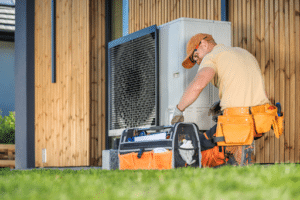During the cold winter weather, we gladly seek refuge in the reassuring warmth of the indoors. Unfortunately, there are times when the temperatures drop so low that even your room doesn’t feel warm enough. You can try to increase your body temperature by wearing an extra layer of clothing, but this isn’t a long-term solution. There are much better ways to keep a room warm in your house.
If you find yourself shivering inside the house, this probably means your room temperature isn’t adjusted at an optimal level. You will need to come up with intuitive ways to increase the indoor temperature. The following are eight ideas on how to keep a room warm without wasting too much energy or too much money:
1. Fix your furnace.

Homeowners are recommended to install a furnace unit for the winter season. This is the easiest way on how to keep a room warm in your home. As long as your furnace system is properly running, you can crank up the indoor temperature and the warm air will be distributed to every room of the house.
Unfortunately, there are occasional furnace problems that will affect the unit’s performance. If you are already using a furnace and the rooms still feel rather cold, that may signify your system isn’t efficient or powerful enough to warm up the entire house. Most likely, there are maintenance issues within your furnace. In order to restore the warmth in your rooms, you need to get the furnace inspected and repaired as soon as possible.
2. Adjust your smart thermostat.

Smart thermostats are programmable devices that make automatic adjustments to achieve the ideal room temperature. These devices come with many technologically advanced features, including the automated changes to the temperature based on whether anybody is inside the house.
While these smart devices are mostly accurate, the technology is not always precise. These thermostats may be programmed to determine the most suitable temperature, but a computer algorithm is ultimately not the same as human intuition. If you feel like the rooms aren’t warm enough, then you need to adjust the thermostat. You should check the thermostat settings and make overriding changes as deemed necessary.
3. Increase the room humidity levels.

Humidity helps to increase the temperature of the air inside your home. If a room feels too dry during the winter, it could be a good idea to invest in an energy-efficient humidifier.
If possible, try letting the bathroom door open when you take a shower or a warm bath. This is an easy way to increase the humidity levels in your home, which will make the rooms feel a bit warmer. If you love taking hot baths, wait until the water has cooled down completely before draining it, as the warmth will transfer to the ambient air.
4. Insulate your walls.

A lot of the indoor heat escapes through the walls. If you are planning to invest in a home renovation, this would be a great time to add some insulation to your walls. You will want to install thermal insulation that reduces heat loss, which can result in warmer rooms across the house.
It’s also possible to insulate your walls without undergoing a major renovation process. You can hang some decorative tapestries on your walls, which will help to insulate a room during the winter.
5. Secure the windows within your rooms.

Are your windows drafty? If they are, some of that precious warm air is escaping your home through little gaps and cracks. You can use a window insulation kit to seal all these openings, which will minimize heat loss and make the rooms feel warmer.
Thick curtains and shades will also help to insulate your windows. However, make sure you don’t keep the curtains closed all the time. In the mornings, open the curtains to allow in the sunshine, which will naturally warm up the room. When it starts to get dark outside, close the curtains again to trap the heat inside your home during the night.
6. Keep all the doors shut.

Doors are important gateways that prevents the cold weather outside from infiltrating the warmth inside your home. Every time you open an outside door, it only takes moments for the cold air to occupy and fill all the indoor spaces. This cold air can travel through every room of the house if you leave the doors open. You need to keep the doors shut in order to retain the heat inside and keep the cold outside.
In addition, you may find a small indiscernible gap at the bottom of your outside doors. This tiny opening may be the reason why cold air seeps into the room. To prevent this, you should use draft stoppers and place them along the bottom of the doors.
7. Turn on the ceiling fan.

Ceiling fans are typically associated with cooling down a room during summer. However, these fans can also keep a room warm in the winter season. When the ceiling fan turns in a clockwise direction, it will pull cool air upwards and push warm air downwards. All this hot air will circulate around the surroundings and make the rooms feel generally warmer.
8. Heat up the kitchen.

Kitchen appliances generate a lot of warmth, and this warmth can quickly spread to the rest of the house. Since the winter season is a perfect occasion to cook up delicious comfort food, you can prepare your favourite dishes and warm up the house at the same time. When you are done with the oven, leave the door open so the leftover heat can warm up the room.
If you don’t feel like cooking, you can still use a kettle or a pot to boil some water. This activity will warm up your kitchen, and the hot water can be consumed to raise your body temperature as well.



